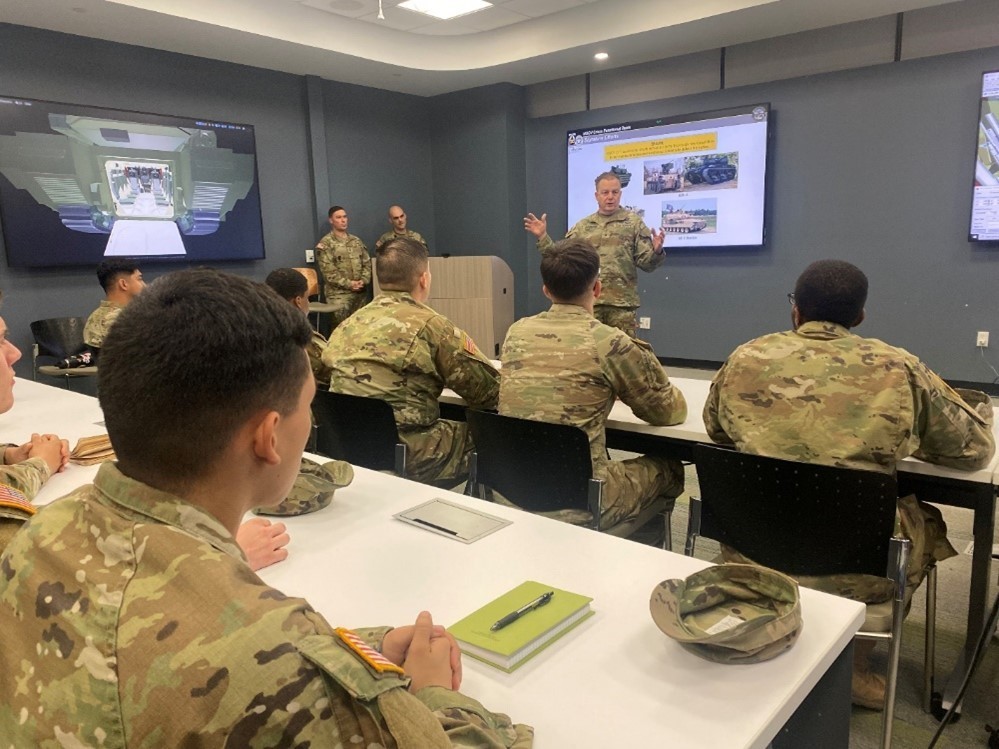By Dan Heaton, Next Generation Combat Vehicles Cross-Functional Team
A squad of Soldiers from Fort Riley, Kansas, recently wrapped up a crucial two-week Soldier touchpoint on the Army’s XM30 Combat Vehicle program. The XM30 is a fighting vehicle that the Army will begin to field by the end of the decade, bringing new capabilities to the fight and transforming Armored Brigade Combat Teams.
“I appreciate the level of focus and interest the engineers and design team who are working on the XM30 have in our input,” said Sgt. 1st Class Isaac Busch, 1-18 Infantry, 2nd Brigade Combat Team, 1st Infantry Division. “The XM30 will be a massive upgrade in lethality for our formations.”
Busch was one of a dozen Soldiers who spent much of January at the Detroit Arsenal, reviewing plans and interacting with mock-ups of potential future designs of the XM30, providing insights on what the Soldiers liked or didn’t like about the possible designs. Two vendors — General Dynamics Land Systems and American Rheinmetall Vehicles — are under contract by the Army to provide prototype vehicles for test and evaluation. Ultimately, one vendor’s vehicle will be selected, in late Fiscal Year 2027, for production. The touchpoint allowed the two vendors to get feedback from the ultimate end user before beginning to build the first prototypes.
“My Soldiers have hundreds, probably thousands of hours of on the ground experience in the Bradley [Fighting Vehicle], both as a dismount and in the turret,” Busch said. “We’re using that experience to advise on what we believe works best, based on that experience.”
Among the key features Busch noted and commented on in the future XM30 design were next generation optics, fire control systems and a 50mm weapon system, all of which he said will increase the ability of future formations to engage with and defeat new and greater threats on the battlefield.
Such inputs are at the core of the “Soldier-centric design” approach the Army is using to develop the XM30, which will replace the M2 Bradley in infantry and scout formations.
“The Soldier, specifically our infantry squads, will be the ones who are using the XM30 on the battlefield of tomorrow. It only makes sense to get their inputs on how the vehicle is designed,” said Brig. Gen. Geoffrey Norman, director of the Next Generation Combat Vehicles Cross-Functional Team (NGCV CFT).

The NGCV CFT is working closely with the Program Executive Office – Ground Combat Systems (PEO-GCS) and other Army commands on the development of the XM30. Both NGCV CFT and PEO-GCS are based at the Detroit Arsenal, the center of the Army’s vehicle design prowess and of the nearby American automotive industry.
The Soldier touchpoint included a number of practical drills, such as timing how long it took a team of Soldiers to dismount from various possible vehicle design configurations. It also included more nuanced discussions about access and placement of panels that provide exterior situation awareness for the Soldiers, and how the engine will be accessible for field-level maintenance. One conversation focused on the configuration of the vehicle’s rear access ramp, which directly impacts a Soldier’s ability to enter or exit the vehicle quickly.
The January Soldier touchpoint is part of the ongoing series of iterations between the Army and the two vendors that have marked the XM30 effort from the start.
Another insight from the touchpoint centered on an area one may not generally consider a priority for an armored combat vehicle — comfort for the Soldier.
“You may have Soldiers who are going to be in the compartment for a long time. You want those Soldiers to be as fresh as possible, ready to immediately dismount and be at top performance to engage an enemy,” said Staff Sgt. John Buenavista, another of the Fort Riley Soldiers who participated in the touchpoint. “I look forward to what XM30 will bring to my unit, whatever unit I may be in, as they start to roll out.”





